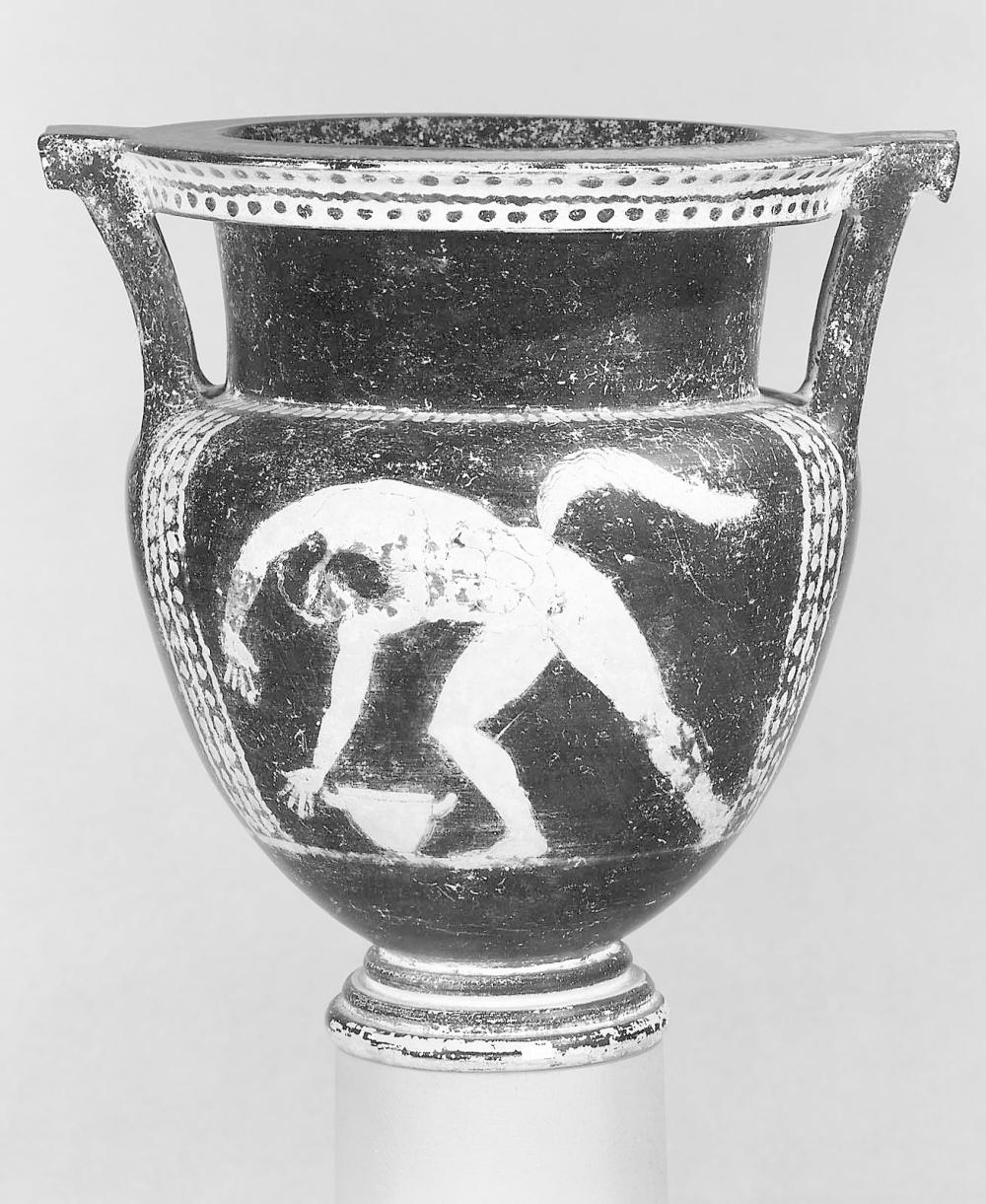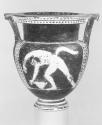Advanced Search
Column-krater
Italic, Etruscan
Classical Period
480–450 B.C.
Medium/Technique
Ceramic, Superposed Color
Dimensions
28.6 cm (11 1/4 in.)
Credit Line
Gift of H. P. Kidder
Accession Number80.595
NOT ON VIEW
CollectionsAncient Greece and Rome
ClassificationsVessels
Catalogue Raisonné
Vase-Painting in Italy (MFA), no. 153.
DescriptionSide A: Bearded satyr turning hand-spring over a cup.
Side B: Bearded satyr chasing a cock.
ITALIAN VASE PAINTING in ITALY, #153 (80.595)
Column-Krater
Etruscan
Attributed to the Praxias Group
about 480-450 B.C.
A: A satyr is about to turn a handspring over a skyphos. Although he is moving to the left, his torso is depicted frontally.
B: A wreathed satyr chasing a cock bends over to the right as he reaches for the bird. Unlike the satyr on side A, he is represented in profile.
Around the top of the rim is a wreath, composed of thick masses of leaves, and on top of each handle-plate is an octopus. The ivy vine on the outer face of the rim is drawn in black glaze on the reserved clay, but the vines framing the sides of both pictures are in added red, like the rest of the ornament. The upper frames are crude, unframed bands of egg-and-dart (or tongue-and-dart). The groundline is a simple stripe that circles the lower body.
Both the style of the figures and the shape of the vessel betray a strong Attic influence, but other features are non-Attic: the differences in the foot and rim already mentioned, the form of the wreath on the rim, the egg-and-dart ornament, and the use of superposed color with incised details on a krater. Within the Praxias Group, the satyrs are perhaps best compared to those on a hydria in the Thorvaldsen Museum, Copenhagen (T. Melander, "Thorvaldsens graeske Vaser"
[Copenhagen, 1984],p.45, fig. 23).
Vases of the Praxias Group are thought with virtual unanimity to have been produced at Vulci.
Side B: Bearded satyr chasing a cock.
ITALIAN VASE PAINTING in ITALY, #153 (80.595)
Column-Krater
Etruscan
Attributed to the Praxias Group
about 480-450 B.C.
A: A satyr is about to turn a handspring over a skyphos. Although he is moving to the left, his torso is depicted frontally.
B: A wreathed satyr chasing a cock bends over to the right as he reaches for the bird. Unlike the satyr on side A, he is represented in profile.
Around the top of the rim is a wreath, composed of thick masses of leaves, and on top of each handle-plate is an octopus. The ivy vine on the outer face of the rim is drawn in black glaze on the reserved clay, but the vines framing the sides of both pictures are in added red, like the rest of the ornament. The upper frames are crude, unframed bands of egg-and-dart (or tongue-and-dart). The groundline is a simple stripe that circles the lower body.
Both the style of the figures and the shape of the vessel betray a strong Attic influence, but other features are non-Attic: the differences in the foot and rim already mentioned, the form of the wreath on the rim, the egg-and-dart ornament, and the use of superposed color with incised details on a krater. Within the Praxias Group, the satyrs are perhaps best compared to those on a hydria in the Thorvaldsen Museum, Copenhagen (T. Melander, "Thorvaldsens graeske Vaser"
[Copenhagen, 1984],p.45, fig. 23).
Vases of the Praxias Group are thought with virtual unanimity to have been produced at Vulci.
Provenancegift of Henry P. Kidder to MFA, October 21, 1880



